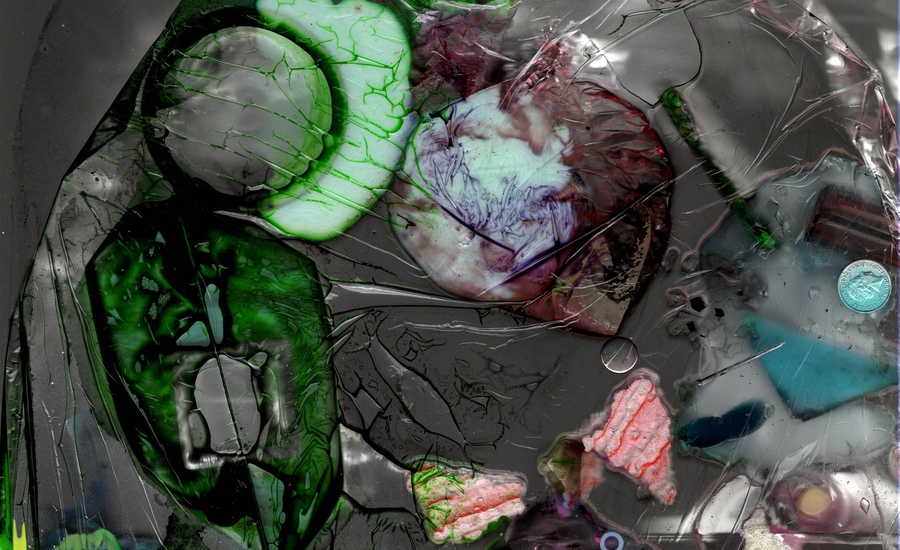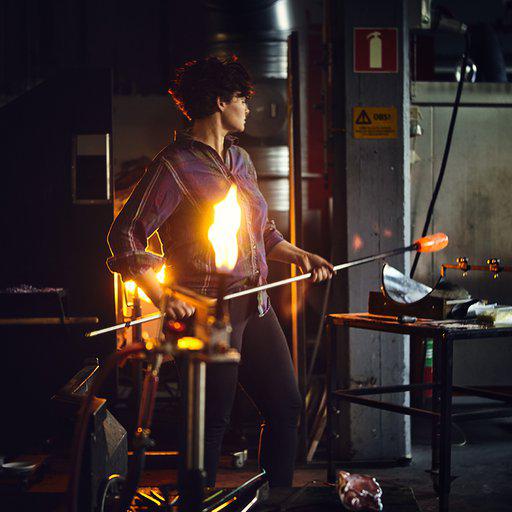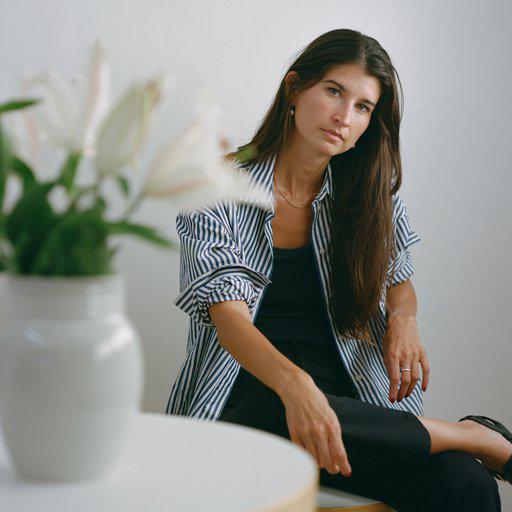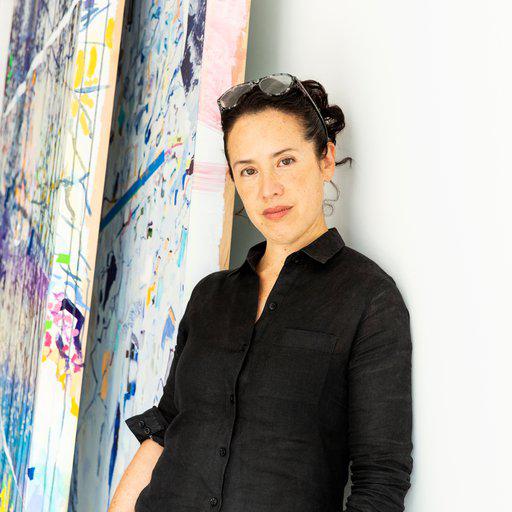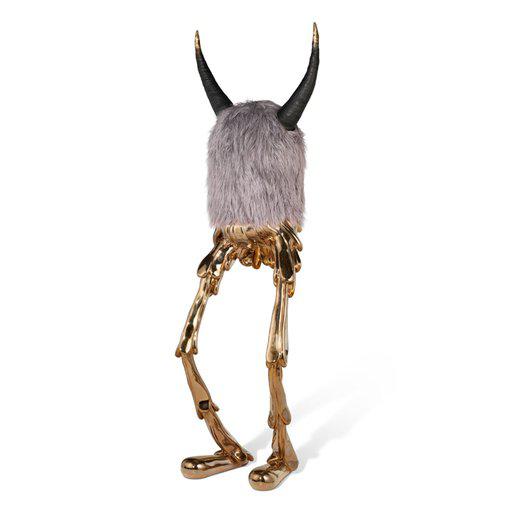How did Samara Scott prepare for her inclusion in the New Museum's 2021 Triennial, Soft Water Hard Stone ? In the same way she often prepares for a show - by carrying out a series of experiments. The London-born artist will select consumer products, organic materials, as well as items drawn from some indeterminate point on the consumer-waste spectrum, to see how these materials interact with one another. Tin foil, tights, candles, nail polish, milk, mustard, lettuce leaves, weeds pulled from pavements, and even catering waste, make it into her art.
Consider the constituent parts of this impressive artist’s work (Scott was born in 1985, and graduated from the Royal College of Art in 2011) and it’s hard not to view her work as both oddly personal (she has described her work as “confessional impressionism”) and an indictment of capitalism and overconsumption. See these familiar objects, floating in an unfamiliar setting, and it’s easy to see their beauty, as well as echoes of a wide range of artists, from Rauschenberg to Pollock , Tracey Emin to Ana Mendieta .
This tension between easy, cheap, eye-catching bounty and wanton detritus, has captivated audiences across the world. In a 2016 profile in the New York Times, the paper praised the way “layers of iridescent liquids used to scrub our homes and our skin become both broad and bodily” in Scott’s work. At Frieze Art Fair in London that same year her sculptural installation Lonely Planet 2 (a low pool filled with everything from fabric softener to noodles) sold for $20,000; and in 2020, the French paper Liberation praised The Doldrums, Scott’s massive installation at CAPC in Bordeaux (a huge, translucent ceiling covered with detritus) as a work that “echoes the state of the world.”
Now, you too enjoy those echoes in your own home, via a new, limited edition Samara Scott print made by the artist in conjunction with The New Museum, Phaidon and Artspace and launched next week.
The print Gargoyle, 2021 (created as part of Soft Water Hard Stone ( if you can't visit the exhibition, which closes this weekend, you can buy the accompanying Phaidon book here ) relates to Scott’s large-scale, site-specific, mixed-media installation on the New Museum’s façade, Gargoyle (Lonely Planet) (2021), in which the artist repurposed and recombined diverse materials to transform them into vibrant, viscous abstractions.
Juxtaposing and intermixing the everyday substances that surround us, Scott layers and collages liquids like fabric conditioner, energy drinks, and hair gel with items such as coins, cigarette butts, and broken jewelry. For Gargoyle (Lonely Planet), she composed her signature array of flotsam and jetsam against the Museum’s tall glass windows, the shifting sunlight and the building’s interior lights becoming the work’s collaborators.
This print takes Scott’s alchemical explorations to the glass surface of the flatbed scanner to create a high-definition photographic image. Her accumulation and alteration of materials call attention to the madness of global production and waste, as well as the creative potential to transcend the shattered remnants of these systems that permeate our culture.
To mark the edition , we sat down with Scott, who now lives on the south coast of the UK, to discuss her unusual choice of media, her working practises and why videos from abattoirs have become one of her more unusual sources of inspiration.
 Samara Scott 2021 - photo courtesy the artist
Samara Scott 2021 - photo courtesy the artist
How would you describe what you do? Trying to sit here and summarise - which is so hard to frame for me - it feels so liquid even the way I think about it, or link stuff together.
There are no clear boundaries between the different parts of it – it’s more about spillage, surge and puke. It feels uncontainable to me. There is this defiant liquidity in everything I make. It’s a shifting molten amphibious thing. I don't feel like I have control over it to circle it in a sleek, groomed sentence.
The installations themselves too are more like pourings - so the practice itself is more like heavy clouds, swollen and migratory - which move, drift, and then spill, rain, bleed into spaces, architectures, situations.
Like the show I did for the New Museum Triennial – sloshing, puking, brimming right across that big glass lobby façade.
The work is always concerned with liquidity - suspended planes of alchemy - with a lack of obvious gravity. People like to describe it as being painterly - and it does grapple with this, but I see it much more as action that comes from something photographic - the alchemy that happens in the developing darkroom.
I always make images. Not sculpture, not painting, but images. An image ‘rained into’ a space. Stained into a space. Whether this is at a very delicate scale or on a more architectural scale - more than anything else they are images - spilt still-lifes.
But also, it’s about assemblages, collage. I am very interested in how materials react when they make unusual contrasts and contact - I like to make tensions - sensual tensions between materials. Congestion points. Conflicts.
I think my work relates more to photography. Not the photographs I make but the process of what a photo is. It’s about the site and the magical alchemic absorption of light hitting something and stealing that light, and the development in the dark room of this brothy elixir that spews up an image – the red chemical cooking of it. Negatives aren’t constricted to scale or gravity. There’s encoded interior biology brewing, then you have a script that can blow up to any scale. That's how I translate my studio tests and project them into large-scale installations.
Samara Scott - Gargoyle, 2021. 24 x 18 in (61 x 45.72 cm) Digital C-print on Fuji Crystal Archive Digital Pearl Paper Edition of 60 $1,000 USD
Tell us about the thinking that went into this edition and the original artwork. The image I created is made from a live tracing recording of me manipulating various domestic and cosmetic liquids on a large analogue office scanner bed.
I curdle and meddle and slip and probe about these puddles and curdling patches of liquids - smelting hair gel, mayonnaise, mouthwash, sugar, clingfilm, food coloring, fake blood with nails and coins and pocket fluff. They are mingled in clumps and in gakky swaddles of clingfilm and doggie poop bags. The final image records all the leaking, souring squelch of this propagating matter, which has a marbled beauty to it in this congregating, live moistness.
I keep breaking the scanners because the soapy fluids leech into the machinery. The image looks very digital, unreal, quite cosmic. But if you study it, the visual data is quite wonderfully pathetic, Vaseline smears and spud froth and saliva.
I wanted to make something that had a direct relationship with the viral fluid clots that span the museum’s windows and facade, and although it’s on a different horizon and scale, it still maintains a direct relationship with the original piece - where both ‘fields’ or ‘friezes’ record and archive live and volatile materials in this tidal drift - a kind of lonely planet belch.
How did you prepare for t he New Museum triennial? I always make work on site, almost peversely moving my whole studio set up and nearly camping out in a space and working very physically, almost bodily within an architecture, spilling or streaming these tidal archives into the grooves and seams and crotches and armpits of a building. With Soft Water Hard Stone, this transient making had to be very malleable in my head - for the first time (because of the pandemic) I had to think about how to adapt and translate my practice and work in this more hybrid way - preparing for multiple contingent situations.
I didn't get confirmation I would be able to travel to the US and work onsite until a few weeks before - at the same time I was preparing elements of the work to get shipped. I was pouring these huge liquid latex puddles all over my studio floor. My studio is big, but the whole floor space was coated with these brewing hash-clotted infusions - I had to leap in between them, skidding on them. It was such a relief that I got to travel and work on site - where I melded and remade and coalesced, splitting and merging new parts.
I had no plan of the composition (I never do), just some loose sketches. I had to feel out the space. And I kept pushing and leaking into the corners, absorbing, contaminating more space. I ended up taking over the entire window span.
There’s a lot going on - structurally as well as visually - how do you work? On the floor? On the wall? Does it differ? Ha! I work EVERYWHERE in my studio. I am infinitely restless, almost manic, and I find that working on multiple sites and surfaces and experiments propagates the most chaos and the most sprouts - the more fanatical and fitful it gets in those early testing phases the more I seem to harvest things that are more irrational and turbulent and unpredictable.
How do the various elements come together practically and philosophically? I start slow, work on a million swatches of things and kind of jerk and flit between them. The restlessness grows and rises and often ends in a frenzy, a climax. I often leave the studio in a binge of mess. When I tidy too much, I can get lost. I think of my studio as a ‘holding’ space where I keep the objects, the ‘clippings’. Building a show is really developing a system to mount this material into - ‘exposures’ (the photography thing again) - rousing the materials out of the sedateness of the studio archives into spreads of tapestries, friezes, on floors, windows, skies, ponds.
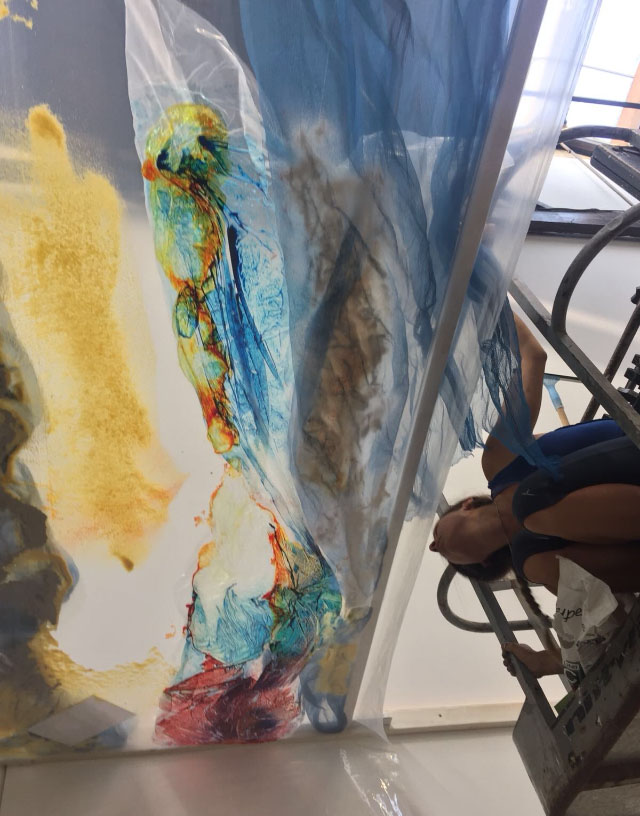 Samara Scott 2021 - photo courtesy the artist
Samara Scott 2021 - photo courtesy the artist
Where did your practice spring from? Collage? A desire to immortalise the everyday detritus of human life? How did it take shape? I was always interested in the things 'already said', 'already out there'. I felt gross and serious making something fresh. What is freshness? Where does the original start? Is it not just a window in the ripening of things that are growing?
All I know is that I don’t like making things from scratch. And I prefer making with leftovers, wilted things. Scrap. It knows itself already, it has a confidence, lived experience, it’s jaded and bruised and addled but full. A block of nude clay, an unopened paint set, a crisp clean paper - terrifying! Who am I to announce myself there? It’s all about voice. I feel I don’t have anything to really say there - only in concoction - with conducting that tangled, complex, bruised and scrambled experience. It’s a resistance to a clean pure thing or product. I want to be an inducer, a translator, I don’t want to be the source, the origin.
The colors are vivid and conventionally beautiful but when one thinks about what they actually are there’s an interesting dichotomy going on, isn’t there? The work changes according to the light - it literally illuminates when the sun touches it. It’s spectral. It’s sap like, goop that glows. It’s lit in different ways from different sides at day or night. It’s double-sided. Like the sea, like a swimming pool. Oceanic. But dirty ocean - infected, carnal. But also, I don’t even find them or want them to be beautiful - I think they are seductive yes but toxic, poisonous colors, too much, too gore, too flirty, too desperate, too accelerated. I like how colors change when they get wet too.
Where do your titles come from? Titles always come almost last. But again, it’s not that neat or linear. They kind of hover around, they are wispy and nibble at and around the whole construction and action of the work. They float and brood backstage. They are very much like the materials that I store and collect. But also, I chose the title for the way it sounds in the mouth. Like a kind of gargle - frothy and globby, mucus, cleansing maybe.
Who were the artists that inspired you when you were younger and who inspires you now? I’m really into these old school cheesy landscape artists Andy Goldsworthy and Nils-Udo . Something about how the gesture is just in these meddlings with resident material - using the live environment as material - like wow it's the most lucid and cogent fabric to carve and cleave and shift right?
That also makes me think of my favorite work ever - John Divola 's Zuma Beach series - those photos he took in that gothic Californian sundown - and the punk lightness of gesture - him entering those abandoned villas. The best work for me involves breaking, and entering, but not taking anything. Mel Bochner ’s photos with all that shaving foam - this impulsive performative gesture I love - so liquid and carnal compared to thos taut, clever paintings. I also collect a lot of reference books and science books and images of viruses and biology. I read a lot of fiction and a lot of sci-fi.
I also look at a lot of architecture - big public spaces interest me. Hotel lobbies, stadia, foyers, shopping centers, worship spaces. The public spaces of Lina Bo Bardi and Noguchi . Public fountains.
I watch a lot of videos about factories, meat robots that work in abattoirs, stacking and slashing. It’s the movements that fascinate and chill me - the semi-human gesture. I think I am drawn to these images in their simultaneous great horror and great beauty. Lately, I can’t stop watching these homemade chicken plucking machines. I also watch a lot of anime and, also, lots of surveillance footage and technical footage of deep under the sea. Sunken cruise ships. I think I am attracted to things which emit a hallucinogenic mourning and hope, bothy psychedelic celebration and lament.











